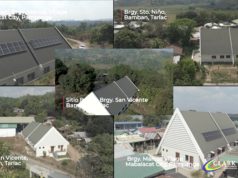More storm surges in Metro Manila. Unending flash floods deluge Central Luzon.
Devastating landslides bury communities in Compostela Valley and Baguio City. Small islands erase from the map. Super typhoons come one after another. Less rice served in the table. Fish is no longer poor man’s source of meat.
Are these scenarios farfetched and unlikely?
Not so, according to the newly-released World Bank report, “Getting a Grip on Climate Change in the Philippines.”
“The Philippines is the third most vulnerable country to weather-related extreme events, earthquakes, and sea level rise. The country’s exposure to extreme weather conditions adversely affects people’s lives, especially those in high-risk urban and coastal areas. Food security is threatened as land and nursery areas for plant, trees, and fisheries are affected by climate change,” said Secretary Mary Ann Lucille Sering of the Climate Change Commission (CCC).
Although climate change affects everyone, it is the poor who are generally affected.
“Informal settlers, which account for 45 percent of the Philippines’ urban population, are particularly vulnerable to floods due to less secure infrastructure, reduced access to clean water, and lack of health insurance,” the World Bank report pointed out.
As disaster-prone country, the Philippines is already feeling the impacts of climate change.
“By virtue of its location, climate, and topography, the Philippines is exposed to a range of climate-related hazards,” the report said. “Sixteen of its provinces are among the top 50 most vulnerable regions in Southeast Asia.”
Some of the climate-related impacts which are projected to increase in the coming decades:
• More intense typhoons, whose storm surges will be superimposed on higher sea levels. Storm surges are projected to affect about 14 percent of the total population and 42 percent of the coastal population.
• A 30-centimeter sea level rise by 2040 is expected to reduce rice production in the region’s major rice growing areas by about 2.6 million tons per year.
• Warming oceans and ocean acidification affect coral reefs, which serve as important feeding and spawning grounds for many fish species that support the livelihoods of fisher folk.
As the country is vulnerable to the effects of climate change, the report urges the government to implement “the measures needed to protect itself against ever-increasing climate change and variability.”
The report cited the current Philippines Development Plan, which aims to accelerate annual economic growth of the country to 7-8 percent.
“Unless it is planned and carried out with accommodation to future climate change in mind, the development plan could be locked into infrastructure development, land use changes and urbanization processes that are more vulnerable to climate risks,” the report explained.
Since the process of developing institutions to implement climate reforms can be lengthy, the report suggested: “The time to start acting is now.”
Scientists attribute climate change to the rise in global temperature brought about by increased emissions of greenhouse gases such as carbon dioxide and methane. Increased emissions of these gases have been attributed to human activities such as burning of fossil fuels in motor vehicles and power plants, degradation of forests, and change in land use.
Globally, the Philippines is a minor global contributor to climate change. “The Philippines’ greenhouse emissions rank in the top 25 percent of low and middle income countries, with significant increases projected in the coming decades,” the report said.
“Emissions from the energy sector are projected to quadruple by 2030, and the transport sector is expected to double its emissions,” the report added.
In the report’s foreword, Sering reiterated: “For the Philippines to reduce poverty, accelerate economic growth, and create jobs, it is therefore necessary to address the country’s vulnerabilities to climate change.
“This can be accomplished by reducing the exposure and improving the adaptive capacity of communities are risk,” Sering pointed out.




